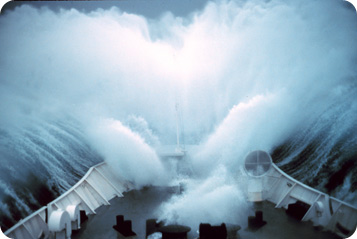In late 1942, the Queen Mary was carrying 15,000 American troops across the Atlantic to join the war in Europe. German U-boats couldn’t catch her, and even a stiff gale wasn’t a problem for the mammoth ocean liner.
 Rogue waves tower high above the waves around them. Credit: National Oceanic and Atmospheric Administration
Rogue waves tower high above the waves around them. Credit: National Oceanic and Atmospheric AdministrationBut 700 miles off the coast of Scotland, a wall of water more than 90 feet tall broadsided the ship, almost knocking it on its side. Water poured onto the decks, and just a few more degrees of list would have capsized her. But the Queen slowly righted herself and delivered her passengers to the British Isles.
In recent years, oceanographers have realized that such waves aren’t all that rare. They’re called “rogue” waves, and they tower high above the other waves around them. They’ve damaged many ships, and may have sunk many others.
Scientists are still figuring out how these waves are created.
They’re most common in areas where strong ocean currents are running in the opposite direction of the wind-driven waves, often near the edge of the continental shelf. As these two forces fight each other, the waves pile up to greater heights.
Others may form when two or three separate sets of waves come together. And still others -- especially out in the deep ocean -- may form when one wave “steals” energy from the waves around it.
The biggest rogue waves ever observed were around 100 feet high -- an almost vertical wall of water with a big trough in front of it. But some calculations show that they could grow up to 200 feet tall. Not even the Queen Mary could survive the power of such a monster.

